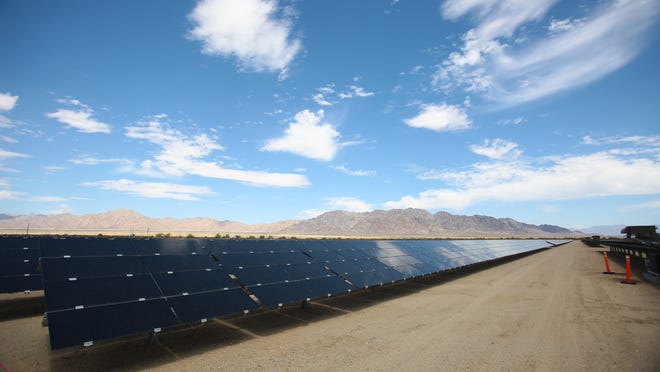[ad_1]

The Trump administration plans to approve a massive solar power plant in the Southern California desert — and some environmentalists aren’t happy about it.
President Trump’s Interior Department has pushed for more fossil fuel drilling on public lands and waters, announcing this week it will hold the largest oil and gas lease sale in U.S. history, offering 77 million acres for leasing in the Gulf of Mexico. Meanwhile, Interior Secretary Ryan Zinke has criticized solar farms on federal lands, saying last month that land devoted to solar panels is “no longer useful for anything else.”
But the Interior Department said Thursday it will move forward with the Palen solar farm, which has been in the works since 2009 and would be built on public lands between Joshua Tree National Park and Interstate 10, in the open desert east of the Coachella Valley. Palen would be the fifth large-scale scale solar farm in Riverside County, and would help reduce the greenhouse gas emissions that cause global climate change.
Despite those climate benefits, some environmental groups have spent years fighting Palen, saying it would disrupt sensitive desert ecosystems and harm lizards, tortoises, birds and other animals. Native American groups have criticized the solar project as well, saying it would destroy ancient tribal artifacts and sacred sites.
THE CURRENT: Sign up for The Desert Sun’s energy and water newsletter

The Interior Department’s Bureau of Land Management said Thursday it doesn’t plan to reject the Palen solar farm. But rather than accept the project layout preferred by the developer, San Diego-based EDF Renewable Energy, the agency has selected a layout with a smaller land footprint. That layout would limit the solar plant’s size from 4,200 acres to 3,100 acres without reducing its power capacity, a whopping 500 megawatts.
The reduced-footprint plan creates environmental trade-offs, Palen critics say. While the project would be smaller, it would extend further into a sand transport corridor that feeds the sand-dune habitat of Mojave fringe-toed lizards, desert kit foxes and other species.
While the modified layout might hurt those lizards and foxes, it could help other species. The reduced-footprint plan would involve building around a large dry wash that runs through the project site, where EDF had proposed to install some solar panels. Avoiding that wash could limit the damage to microphyll woodlands, where occasional bursts of water nourish vegetation that provides habitat for birds, mammals and reptiles.
“The washes are the places in the Sonoran Desert where you find trees. And the trees are important for the migration of birds, and the sustenance of so many (bird) species that live in that part of the desert permanently, and the species that migrate through on their way to the Salton Sea,” said David Lamfrom, director of California desert and national wildlife programs at the nonprofit National Parks Conservation Association.

Still, Lamfrom said, Californians shouldn’t be forced to choose between protecting sand dunes and protecting vegetation-rich woodlands.
“Both of those habitats are incredibly important to the functioning and wellbeing of the desert,” he said.
An EDF representative didn’t respond to questions Thursday about when the company hopes to start building Palen. The developer signed a contract earlier this year to sell the electricity the solar farm will generate to the utility Southern California Edison, meaning the last obstacle to construction is approval from the federal government. That approval is expected following the completion of an environmental review process.
The Bureau of Land Management and Riverside County released a draft environmental impact report for Palen on Friday, kicking off a 45-day public comment period that ends at 5 p.m. on December 11. Comments can be emailed to PalenSolar@blm.gov, or sent by mail to Palen Solar Project, c/o Aspen Environmental Group, 235 Montgomery Street, Suite 935, San Francisco, CA 94104.
There will be a public comment meeting on November 14 from 4-6 p.m. at UC Riverside’s Palm Desert campus, located at 75080 Frank Sinatra Drive.
The federal agency had also considered a project layout that would have reduced Palen from 4,200 acres to 1,620 acres and from 500 megawatts to 230 megawatts, so as to avoid sensitive habitats more completely. That configuration would have followed the rules laid out in the Desert Renewable Energy Conservation Plan, an Obama-era road map for protecting desert ecosystems while encouraging clean energy development.
But Palen was proposed before the plan was finalized in 2016, meaning Trump administration officials don’t have to follow those rules for Palen.

The German firm Solar Millennium first proposed to build a solar farm at the Palen site in 2009. The project has gone through several owners, technologies and configurations since then. It’s been delayed by corporate bankruptcies, regulatory rejections and protests from conservationists. EDF acquired the project from the Spanish firm Abengoa Solar last year and quickly announced its intention to switch from the mirror-based “solar tower” technology favored by previous developers to traditional solar panels.
EDF also signed a contract last year to sell electricity from its 150-megawatt Desert Harvest solar farm, which would be built on 1,200 acres of federal land near Palen. The two solar plants would join the nearby Desert Sunlight facility — which at 550 megawatts was the world’s largest solar farm when it opened — and three Riverside County projects near the Arizona border, known as Blythe, McCoy and Genesis. Several other solar farms are being developed on public land in the county, including SunPower’s 4,000-acre, 400-megawatt Arica project; Recurrent Energy’s 2,900-acre, 350-megawatt Crimson project; and First Solar’s 4,800-acre, 300-megawatt Desert Quartzite project.
RELATED: Why fighting climate change won’t destroy the economy
Riverside County has become a hotbed of solar development due to the region’s year-round sunlight and vast stretches of undeveloped land. But the solar industry is booming nationally, too, due to falling costs and state and local policies aimed at fighting climate change. The federal government’s Bureau of Labor Statistics projected this week that ‘solar-panel installer’ will be the nation’s fastest-growing job over the next decade, with employment more than doubling from 11,300 installers last year to 23,200 in 2026.
The second-fastest growing job, according to the latest federal projections? Wind turbine service technician.
Sammy Roth writes about energy and the environment for The Desert Sun. He can be reached at sammy.roth@desertsun.com, (760) 778-4622 and @Sammy_Roth.
[ad_2]
Source link



